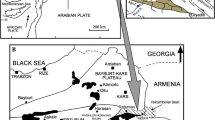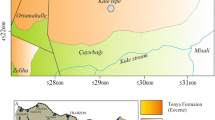Abstract
The Aliança Formation, within the Brazilian Recôncavo–Tucano–Jatobá Rift System, is a succession of Late Jurassic sedimentary rocks that record the maximum flooding surface of shallow Capianga Lake in the Afro-Brazilian Depression, Gondwana. Several aulacogens and drift-marginal Mesozoic basins of eastern Brazil and western Africa recorded the great extensional event that occurred during the early stage of Gondwana break-up. Lithologic, petrographic, micropaleontological and geochemical analyses of lacustrine carbonates collected near the city of Ibimirim, Pernambuco State, were carried out to establish the paleolimnological evolution of a marginal area of Capianga Lake, in the Jatobá Basin. The ostracode fauna, obtained from grainstone and calcareous quartzarenite, is constituted by Theriosynoecum pricei, Theriosynoecum uninodosa, Theriosynoecum quadrinodosum, Reconcavona? jatobaensis and Alicenula? spp. Carbon and oxygen stable isotopes in bulk rock, Theriosynoecum pricei and Alicenula? spp. were measured. Theriosynoecum pricei displays the most negative δ13C values, between − 2.1 and − 1.3‰. The δ13C values obtained from Alicenula? spp. and bulk rock were also negative. The δ18O values for Theriosynoecum pricei range from − 10.1 to + 4.1‰. Alicenula? spp. show δ18O values between − 4.6 and + 5.8‰. The bioclastic character of the carbonates and the presence of cross-bedding and ripple marks suggest deposition in a low-energy, low-gradient, ramp-type littoral zone of a shallow, balanced-fill lake. The ostracode association, characteristic of permanent, alkaline, freshwater bodies, corresponds to the Theriosynoecum pricei ostracode biozone, which is of Tithonian age. The lithofacies, along with covariation of δ13C and δ18O, and large δ18O fluctuations, suggest that this marginal area of Capianga Lake was characterized by stable hydrological conditions in a closed basin. The δ13C values display a slightly narrower range, suggesting oligotrophic to slightly mesotrophic conditions, and holomixis in this marginal area of Capianga Lake.







Similar content being viewed by others
References
Bate RH (1999) Non-marine ostracod assemblages of the Pre-Salt rift basins of West Africa and their role in sequence stratigraphy. In: Cameron NR, Bate RH, Clure VS (eds) The Oil and Gas Habitats of the South Atlantic. Geol Soc Lon Spec Publ, vol 153, pp 283–292
Bennett CE, Williams M, Leng MJ, Siveter DJ, Davies SJ, Sloane HJ, Wilkinson IP (2011) Diagenesis of fossil ostracods: Implications for stable isotope based palaeoenvironmental reconstruction. Palaeogeogr Palaeoclimatol Palaeoecol 305:150–161
Bohacs KM, Carroll AR, Neal JE, Mankiewicz PJ (2000) Lake-basin type, source potential, and hydrocarbon character: an integrated sequence-stratigraphic-geochemical framework. In: Gierlowski-Kordesch EH, Kelts KR (eds) Lake basins through space and time. AAPG Studies in Geology, vol 46, pp 3–34
Caillaud A, Blanpied C, Delvaux D (2017) The Upper Jurassic Stanleyville Group of the eastern Congo Basin: An example of perennial lacustrine system. J Afr Earth Sci 132:80–98
Caixeta JM, Bueno GV, Magnavita LP, Feijó FJ (1994) Bacias de Recôncavo, Tucano e Jatobá. Bol Geocienc Petrobras 8:163–172
Carroll AR, Bohacs KM (1999) Stratigraphic classification of ancient lakes: balancing tectonic and climatic controls. Geol 27:99–102
Cohen AS, Dussinger R, Richardson J (1983) Lacustrine paleochemical interpretations based on eastern and southern African ostracodes. Palaeogeogr Palaeoclimatol Palaeoecol 13:129–151
Colin JP, Dépêche F (1997) Faunes d’es ostracodes lacustres de bassins intra-cratoniques d'age albo-abtien en Afrique de l'ouest (Cameroun, Tchad) et ao Brésil: Considérations d'ordre paléoécologique et pléobiogéographique. Afr Geosci Rev 4:431–450
Costa IP, Bueno GV, Milhomem PS, Silva HS, Kosin M (2007) Sub-bacia de Tucano Norte e Bacia de Jatobá. Bol Geocienc Petrobras 15:445–453
Cyr AJ, Currie BS, Rowley DB (2005) Geochemical evaluation of fenghuoshan group lacustrine carbonates, north-central Tibet: implications for the paleoaltimetry of the eocene Tibetan Plateau. J Geol 113:517–533
Decrouy L, Vennemann TW, Arieztegui D (2011) Controls on ostracod valve geochemistry: Part 2. Carbon and oxygen isotope compositions. Geochim Cosmochim Acta 75:7380–7399
Dunham RJ (1962) Classification of carbonate rocks according to depositional texture. In: Ham WE (ed) Classification of carbonate rocks. Tulsa. Am Assoc Petroleum Geologists, Memoir 1, pp 108–122
Dutkiewicz A, Herczeg AL, Dighton JC (2000) Past changes to isotopic and solute balances in a continental playa: clues from stable isotopes of lacustrine carbonates. Chem Geol 165:309–329
Folk RL (1962) Spectral subdivision of limestones types. In: Ham WE (ed) Classification of carbonate rocks. Tulsa. Am Assoc Petroleum Geologists, Memoir vol. 1, pp. 62–85
Gierlowski-Kordesch EA (2010) Lacustrine carbonates. In: Alonso-Zarza AM, Tanner LH (eds) Developments in Sedimentology 61, Carbonates in continental settings: facies, environments, and processes. Elsevier, Amsterdam, pp 1–101
Guzmán J, Fambrini GL, Oliveira E, Usma C (2015) Estratigrafia da Bacia de Jatobá: Estado da arte. Estud Geol (Recife) 25:53–76
Guzmán-González J, Piovesan EK, Fambrini GL, Oliveira E (2016) Non-marine ostracoda from the Aliança Formation in the north-central portion of the Jatobá Basin, northeastern Brazil. Rev Bras Paleontol 19:15–24
Holmes JA, Street-Perrott FA, Allen MJ, Fothergill PA, Harkness DD, Kroon D, Perrott RA (1997) Holocene palaeolimnology of Kajemarum Oasis, Northern Nigeria: an isotopic study of ostracodes, bulk carbonate and organic carbon. J Geol Soc 154:311–319
Keatings KW, Heaton THE, Holmes JA (2002) Carbon and oxygen isotope fractionation in non-marine ostracods: results from a ‘natural culture’ environment. Geochim Cosmochim Acta 66:1701–1711
Kelts K, Talbot MR (1990) Lacustrine Carbonates as Geochemical Archives of Environmental Change and Biotic/Abiotic Interactions. In: Tilzer MM, Serruya C (eds) Large Lakes, Ecological Structure and Function. Springer-Verlag, Berlin Heildeberg, pp 288–315
Kuchle J, Scherer CMDS, Born CC, Alvarenga RDS, Adegas F (2011) A contribution to regional stratigraphic correlations of the Afro-Brazilian depression - The Dom João Stage (Brotas Group and equivalent units - Late Jurassic) in Northeastern Brazilian sedimentary basins. J S Am Earth Sci 31:358–371
Leng MJ, Marshall JD (2004) Palaeoclimate interpretation of stable isotope data from lake sediment archives. Quat Sci Rev 23:811–831
Leng MJ, Lamb AL, Marshall JD, Wolfe BB, Jones MD, Holmes JA, Arrowsmith C (2005) Isotopes in lake sediments. In: Leng MJ (ed) Isotopes in Palaeoenvironmental Research. Springer, Netherlands, pp 147–148
Mounguengui MM, Lang J, Guiraud M, Jocktane O (2002) Sedimentary dynamics and structural geology of pre-rift deposits of the interior basin of Gabon. J Afr Earth Sci 35:315–329
Myers TS, Tabor NJ, Jacobs LL (2011) Late Jurassic paleoclimate of Central Africa. Palaeogeogr Palaeoclimatol Palaeoecol 311:111–125
Platt NH, Wright VP (1991) Lacustrine carbonates: Facies models, facies distributions and hydrocarbon aspects. In: Anadon P, Cabrera L, Kelts K (eds) Lacustrine Facies Analysis. Int Assoc Sedimentologists Spec Publ 13, pp 57–74
Poropat SF, Colin JP (2012) Early Cretaceous ostracod biostratigraphy of eastern Brazil and western Africa: An overview. Gondwana Res 22:772–798
Rocha DE (2011) Caracterização do intervalo carbonático aptiano da Bacia do Jatobá. Tese Doutorado em Geociências, Universidade Federal de Pernambuco, NE do Brasil
Rocha DE, Amaral, CA (2007) Hidrogeologia da Bacia Sedimentar do Jatobá: Sistema aqüifero Tacaratu/Inajá. Meta B. Caracterização geológica e geométrica dos aqüiferos, CPRM-Universidade Federal de Pernambuco. Rede Cooperativa de Pesquisa, comportamento das bacias sedimentares da região semi-árida do nordeste brasileiro, Ministério de Minas e Energia-Ministério da Ciência e Tecnologia, Brasil
Silva OB, Caixeta JM, Milhomem PS, Kosin MD (2007) Bacia do Recôncavo. Bol Geocienc Petrobras 15:423–431
Silva DR, Mizusaki AMP, Milani EJ, Pimentel M (2012) Depositional ages of Paleozoic and Mesozoic pre-rift supersequences of the Recôncavo Basin in northeastern Brazil: A Rb–Sr radiometric study of sedimentary rocks. J S Am Earth Sci 37:13–24
Talbot MR (1990) A review of the palaeohydrological interpretation of carbon and oxygen isotopic ratios in primary lacustrine carbonates. Chem Geol (Isot Geosci Sect) 80:261–279
Viana CF, Junior EG, Simões IA, Moura J, Fonseca JR, Alves RJ (1971) Revisão estratigráfica da Bacia Recôncavo/Tucano. Boletim Técnico da Petrobras 14:157–192
von Grafenstein U, Erlernkeuser H, Trimborn P (1999) Oxygen and carbon isotopes in modern fresh-water ostracod valves: Assessing vital offsets and autecological effects of interest for palaeoclimate studies. Palaeogeogr Palaeoclimatol Palaeoecol 148:133–152
Whatley RC (1983) The application of Ostracoda to palaeoenvironmental analyses. In: Maddocks RF (ed) Applications of Ostracoda. University of Houston, Geosciences, pp 51–77
Whatley RC (1990) The relationship between extrinsic and intrinsic events in the evolution of Mesozoic non-marine Ostracoda. In: Walliser OH (ed) Kauffman EG. Extinction Events in Earth History, Springer-Verlag, pp 253–263
Acknowledgements
JGG is grateful to UFPE and CNPq for grants awarded during the development of her thesis. We thank Prof. VH Neumann for suggestions on petrography and cathodoluminescence, Prof. VP Ferreira for providing XRF analyses, GM Santana and VS Bezerra for assisting with stable isotope analyses, and RB Amorim and WR Andrade Freitas for support with sample preparation. This is NEG-LABISE contribution Number 278.
Funding
Funding was provided by Conselho Nacional de Desenvolvimento Científico e Tecnológico (Grant Nos. 161599/2014-1, 480275/2012-2).
Author information
Authors and Affiliations
Corresponding author
Additional information
Publisher's Note
Springer Nature remains neutral with regard to jurisdictional claims in published maps and institutional affiliations.
Rights and permissions
About this article
Cite this article
Guzmán-González, J., Sial, A.N., Piovesan, E.K. et al. Paleolimnological reconstruction of a marginal area of Jurassic Capianga Lake, Jatobá Basin, northeast Brazil. J Paleolimnol 63, 113–128 (2020). https://doi.org/10.1007/s10933-019-00105-0
Received:
Accepted:
Published:
Issue Date:
DOI: https://doi.org/10.1007/s10933-019-00105-0





